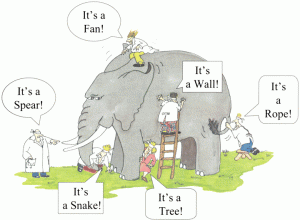Contributing Cancer Models
A key aspect in Cancer Quest – Confirming Cancer’s Cause relates to existing cancer models, and to acknowledge their contribution to the overall cancer puzzle.
Personally[1], I view these six models as presenting the many valid faces of cancer. They are all correct in saying that cancer can be manipulated and turned on or off by their unique model, but it is also obvious that each model is not exclusive and that all other models are simultaneously valid.
In any of the 6 aforementioned cancer models, what if any reference is made to the periodic table of elements? It is a rhetorical question, the answer is, they do not. How is that we can know so much about the body, but refer nothing to the elements that underpin the whole process and are THE components in every structure, every reaction in our body? To close out this page we feel it is useful to associate the six cancer models with the six men of ‘Hindustan’ in the poem below; the poem is an apt description of present day cancer research (singular/silo views)….really smart brains behind each theory, but no vision to tie them together.
<><><><><><><><><><><><><><><><><><><><><><><><><><><><><><><><><><><>

“It was six men of Hindustan, To learning much inclined,
Who went to see the Elephant, (Though all of them were blind),
That each by observation, Might satisfy his mind.
“God bless me! but the Elephant:
Is very like a wall! Is very like a spear! Is very like a snake!
Is very like a tree! Is very like a fan! Is very like a rope!”
And so these men of Indostan, Disputed loud and long,
Each in his own opinion, Exceeding stiff and strong,
Though each was partly in the right, And all were in the wrong!”
(version of an ancient Indian poem)
[1] Flemming H Rasmussen 2012
